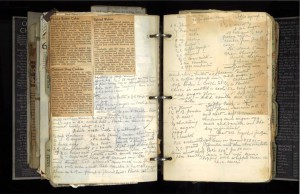 Today, as most of us here in the United States enter our kitchens to cook, prepare, or bake our contributions for Thanksgiving dinner, many of us will reach into our bookshelves and pull out the recipe for those tried-and-true dishes that our families request (or sometimes expect) us to bring to dinner. If your kitchen is anything like mine, these recipes are usually pretty easy to find – they’re the ones on the index cards that have batter and sauce splattered all over them, and in the cookbook with the broken binding that seems to automatically open to the same wrinkled page with ripped edges.
Today, as most of us here in the United States enter our kitchens to cook, prepare, or bake our contributions for Thanksgiving dinner, many of us will reach into our bookshelves and pull out the recipe for those tried-and-true dishes that our families request (or sometimes expect) us to bring to dinner. If your kitchen is anything like mine, these recipes are usually pretty easy to find – they’re the ones on the index cards that have batter and sauce splattered all over them, and in the cookbook with the broken binding that seems to automatically open to the same wrinkled page with ripped edges.
At the end of October, I got my hands on a collection of recipes that is not just a cookbook – it is an encyclopedia. I do not know who the previous owner(s) of this cookbook/encyclopedia was (or were), but I can tell that they really poured their heart and soul into the creation of this collection. As I was flipping through the pages (which is rather difficult since this binder is actually bursting at the seams), I found a recipe for just about any occasion. Stuffing, date bars, tomato preserves, liver fricassee: if you have a craving for it, you could probably find a recipe for it somewhere in the pages of this binder.
Although I thoroughly enjoyed seeing the decades-old clippings from newspapers and magazines taped, glued, and even pinned to the pages of the binder, my favorite finds were the handwritten recipes, or even better, the recipes that had handwritten corrections. These recipes jumped out to me because they reminded me so much of some of the cookbooks that my family has at home. For example, my favorite holding in my mom’s cookbook library, the Better Homes and Gardens Pies and Cakes book, has corrections and comments written in the margins by three generations of my family.
While cookbooks and recipe collections may not constitute primary resources for researching family history, I personally think that you can learn a lot about a family from these volumes: who did most of the meal preparation, favorite family foods, the family’s ethnic or geographical heritage, and even where they got their everyday information. If you look at the bookshelf in my mom’s kitchen, you’ll find a few of the essentials (Joy of Cooking, a few books by Julia Child), and a wide assortment of books on cookies, cakes, pies, and other desserts, many of which were inherited from her mom. Even though baked goods don’t stream constantly from home – much as I wish they would – it definitely shows that a sweet tooth is part of our genetic makeup.
In an attempt to learn more about the former owner(s) of the found recipe binder, I took a closer look at the types of recipes they took the time to include in their personal culinary encyclopedia. While I noticed that there was a rather thick section on canning techniques and recipes for preserves, applesauce, jams, and assorted pickled foods, I was incredibly saddened to see that the smallest section of the binder was dedicated to desserts. That, right there, tells me that there is no chance that I am related to whoever it was who put the collection together.
I think that my next step will be to sit down and really look closely at the newspaper clippings and pieces of scrap paper that fill the leaves of the binder. Hopefully, there will be a clue hidden somewhere in the pages that will lead me towards an answer. However, that will have to wait for another day. I guess I’ll have to return to my own index card with the molasses stain for the pumpkin bread recipe for this weekend’s big gathering. The only decision that remains is which note to follow about whether to add the raisins or not.
Share this:
About Laura Brown
Laura earned a B.A. in History from Boston University, where she focused her studies on 20th century American cultural and military history. Originally from Stockton, New Jersey, Laura completed internships with Historic Newton and Antiques Roadshow before joining the NEHGS staff.View all posts by Laura Brown →